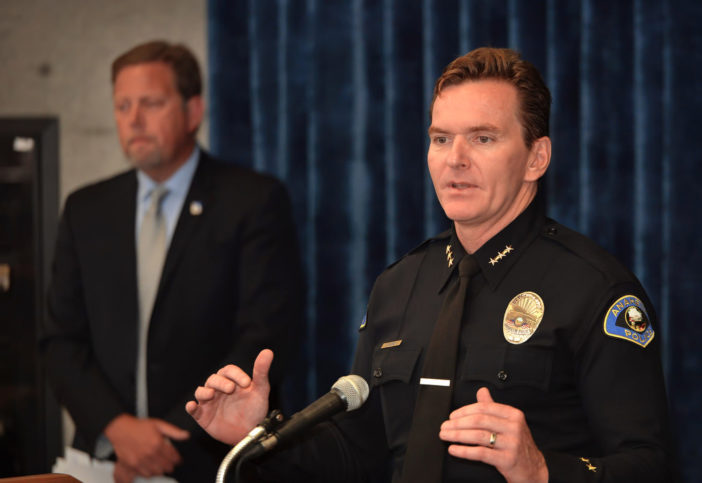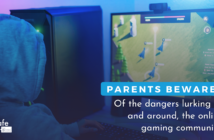The victims, some as young as 12 and overwhelmingly female, are given quotas that can translate to servicing 20 clients a day.
In gated communities, beachfront properties, seedy motel rooms – victims of sex trafficking continue to be forced into depraved and oppressed existences throughout Orange County, a region ripe with clients because of its relative wealth, robust tourist industry and major airport and freeways.
Painting a vivid picture Wednesday of the ongoing problem of sex and labor trafficking in O.C., and what’s being done to combat it, the Orange County Human Trafficking Task Force released its 2015 Human Trafficking Victim Report, which includes insights from victims about how law enforcement and other agencies are treating them.
“This kind of crime…is really a horrible situation,” said Orange County District Attorney Tony Rackauckas, one of several officials who spoke at the news conference at the Anaheim PD, the lead police agency on the OCHTTF, established in 2004 but a fully operational, multijurisdictional task force for the past year.
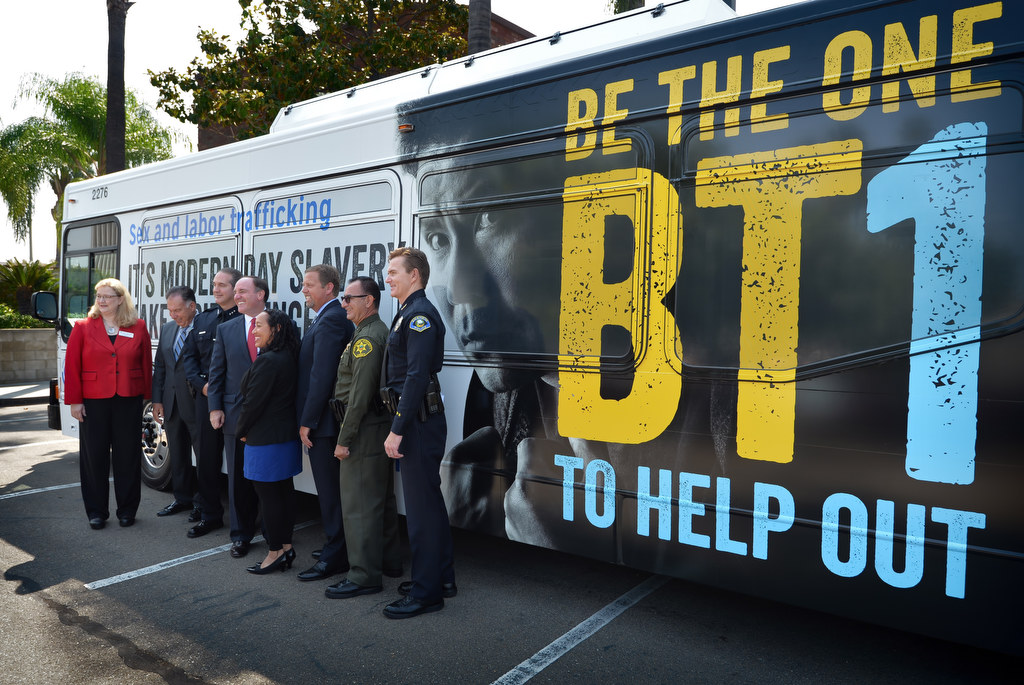
Officials, including Anaheim Deputy Chief Julian Harvey, right, involved with the Orange County Human Trafficking Task Force stand in front of an OCTA bus displaying a new message asking for the public’s help in stopping sex and labor human trafficking.
Photo by Steven Georges/Behind the Badge OC
The level of violence against young women forced into prostitution is “terrible,” said Rackauckas, who said some traffickers — the D.A. called them “slave owners” — have whipped their charges with belts, punished them with ice baths, and burned them with hot irons.
Key findings and other news that came out of the 2015 Human Trafficking Victim Report include:
— A total of 145 victims of human trafficking were assisted in 2014 by the OCHTTF. Of these, nearly three-quarters were victims of sex trafficking — the rest labor trafficking or a combination of the two.
— Since July 1 this year to date, 19 victims of human trafficking in Orange County have been identified, nearly double the number of victims identified monthly over the past three years.
— The Irvine PD is in the process of reassigning a police officer to work on the task force full time, joining the Anaheim PD, OCDA’s Office, Orange County Sheriff’s Dept., FBI and California Highway Patrol as law enforcement agencies that dedicate one or more officers or investigators full time to combat human trafficking.
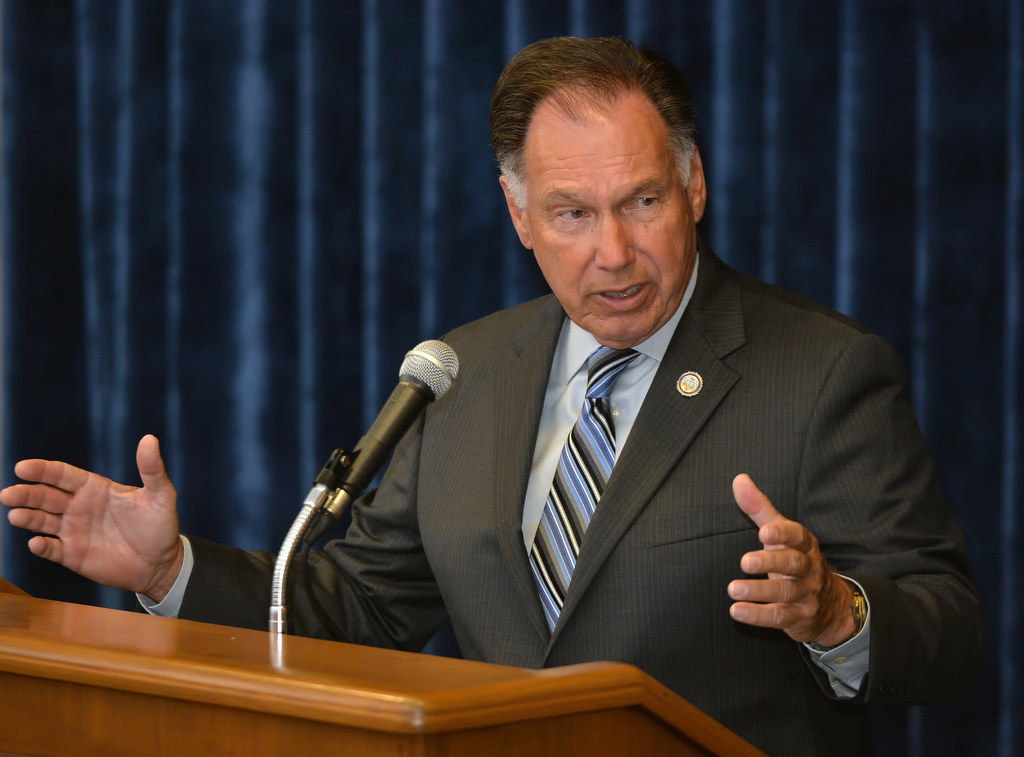
Orange County District Attorney Tony Rackauckas talks about his agency’s special prosecution unit at a news conference on human trafficking at the Anaheim PD on Aug. 19.
Photo by Steven Georges/Behind the Badge OC
—A faith-based advisory council has formed to work with the task force. The panel of 11 leaders from various faiths recently held its first meeting to determine how to best support the needs of survivors of human trafficking.
— The Orange County Transportation Authority, which became a formal partner with the OCHTTF last year, has stepped up a public-awareness campaign to shine a brighter spotlight on a problem many Orange County residents don’t even know exist. Among other efforts, it has added a second 40-foot bus wrapped in an anti-human trafficking message that encourages people to speak up if they notice a possible victim of sex or labor trafficking.
— To date, the OC District Attorney’s Office has prosecuted more than 76 human traffickers, two of whom have received life sentences.
Anaheim PD Deputy Chief Julian Harvey said human traffickers often use a victim’s child or children as leverage or to threaten them to continue keeping them under their thumbs.
“Through an innovative victim-centered approach, this task force provides law enforcement throughout the county the tools and resources and training necessary to identify, investigate and prosecute cases involving human trafficking,” Harvey said at the news conference.
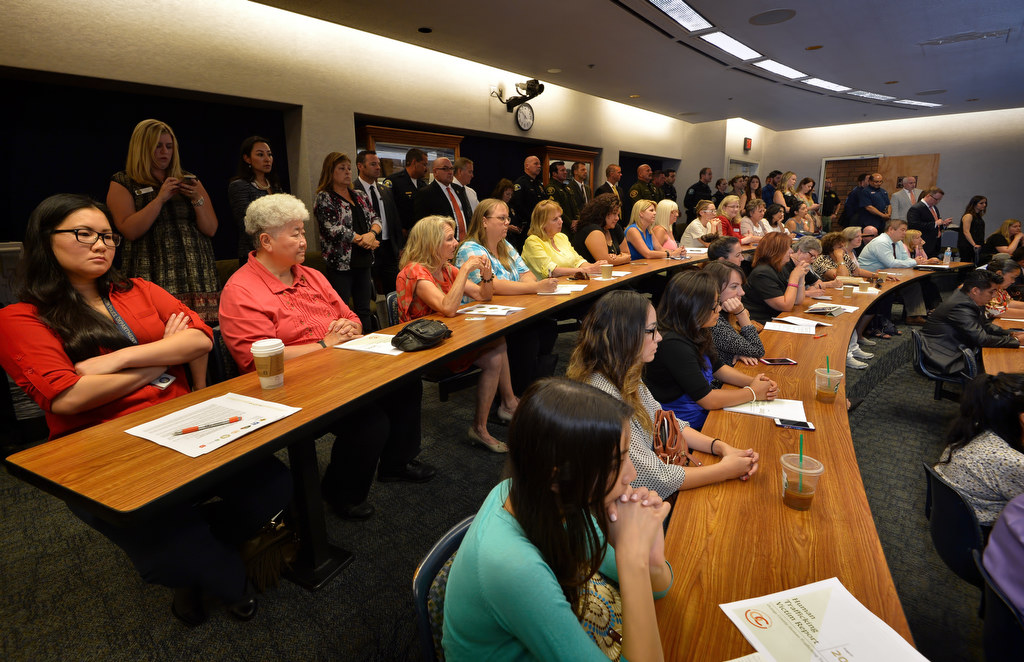
It was standing-room only for those attending the news conference on human trafficking at the Anaheim PD.
Photo by Steven Georges/Behind the Badge OC
Human trafficking crimes are transitory and difficult to investigate and prosecute, Harvey said, but the task force is committed to training law enforcement agencies throughout the county and state to get a better handle on the problem.
In addition to law enforcement agencies and the OCTA, a key partner on the OCHTTF is Community Service Programs, a non-profit that provides counseling and support services to children, adults and families in Orange County who are involved with, or at risk of involvement with, the justice system.
CSP is the administrator of the task force.
Lita Mercado, program director of CSP for the OCHTTF, noted at the news conference that 67 percent of human trafficking survivors are U.S. citizens, shattering a common misperception that most of these girls and young women (only two males were rescued from labor and sex trafficking in Orange County last year) are smuggled in from abroad and forced into labor or sex.
Many human trafficking victims are runaways, homeless and neglected products of broken families, Mercado said — the ideal vulnerable prey for violent predators. Last year, 23 percent of victims served by the task force last year were minors.

Anaheim Deputy Chief Julian Harvey holds a news conference at the Anaheim PD on human trafficking and his agency’s work with the Orange County Human Trafficking Task Force.
Photo by Steven Georges/Behind the Badge OC
Mercado shared at the news conference some insights gleaned from human trafficking about what they need after being rescued by authorities
“Long-term stability is extremely difficult (for them),” Mercado said.
The women need jobs, and moving forward is extremely difficult, she said.
“One (rescued victim) constantly asked her psychologist, ‘When is this pain going to end? When can I stop thinking about what happened?”
Traffickers and pimps, Mercado said, have taken to social media to recruit victims, whose numbers in Orange County are difficult to estimate.
But the problem, Mercado said, is pervasive.
And sometimes victims are reluctant to break out of their situation because they have a difficult time establishing trust with law enforcement and other parties trying to rescue them.
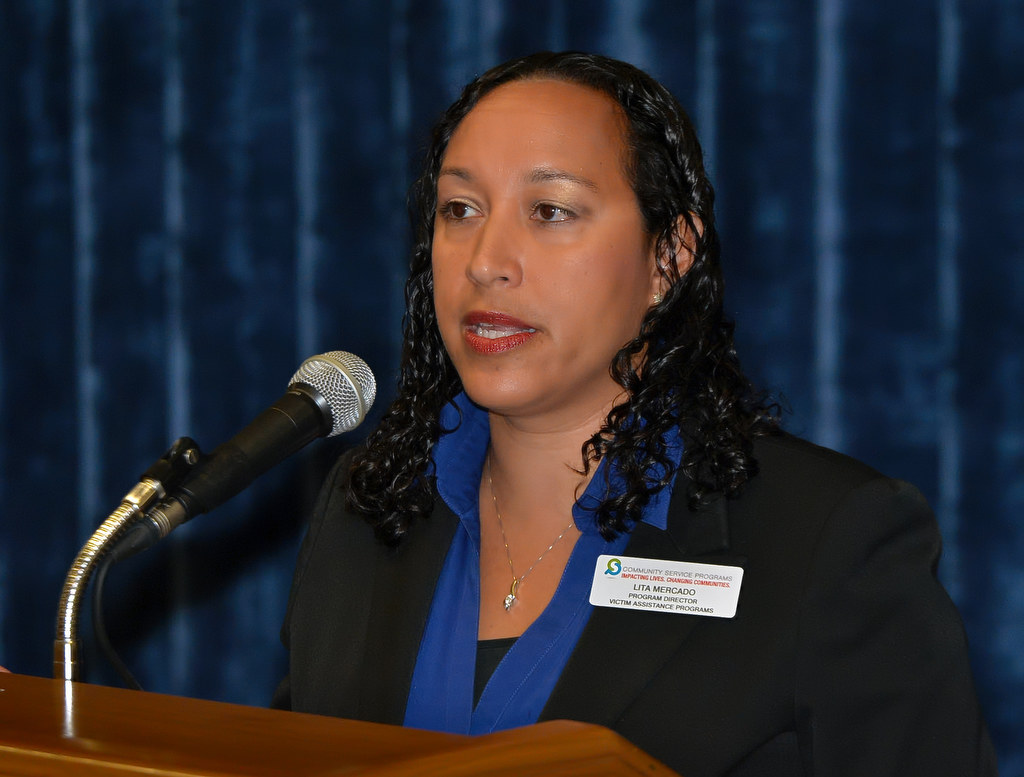
Lita Mercado, program director, victim assistance programs for Community Service Programs, presents findings from the 2015 Human Trafficking Victim Report, during a press conference at the Anaheim PD.
Photo by Steven Georges/Behind the Badge OC
Said Mercado: “We heard things such as, ‘It was hard trusting the police because I didn’t know if it was actually the police or was (a trafficker)…Since the people that did this to me told me they were watching me at all times, I thought they were tricking me.’”
Orange County was one of three areas in the country, along with Chicago and Dallas, to receive federal funding in 2010 to combat human trafficking in a collaborative manner such as that embodied by the OCHTTF, said Ronnetta Johnson, interim executive director of CSP.
“Part of our secret to success is the ‘buy in’ by our entire community,” said Mercado, referring to the recent formation of the faith-based advisory council.
Rackauckas noted at the news conference the formation in his office, in April 2013, of HEAT, for Human Exploitation and Trafficking Unit. Last year the specialized HEAT unit filed more than 40 cases, he said. And he noted a shift in law enforcement from the old thinking of arresting women for prostitution to rescuing them as victims so they can start new lives.
“This task force is saving lives every day,” Rackauckas said.
Darrell Johnson, chief executive officer of the OCTA, said victims of sex trafficking tend to use public transportation — one of the main reasons his agency has stepped up its anti-human trafficking public awareness campaign, called Be the One (BT1).
The campaign includes signs inside buses and at bus stops and inside transit centers, as well as the two bus wraps and a one-minute video that can be viewed here.
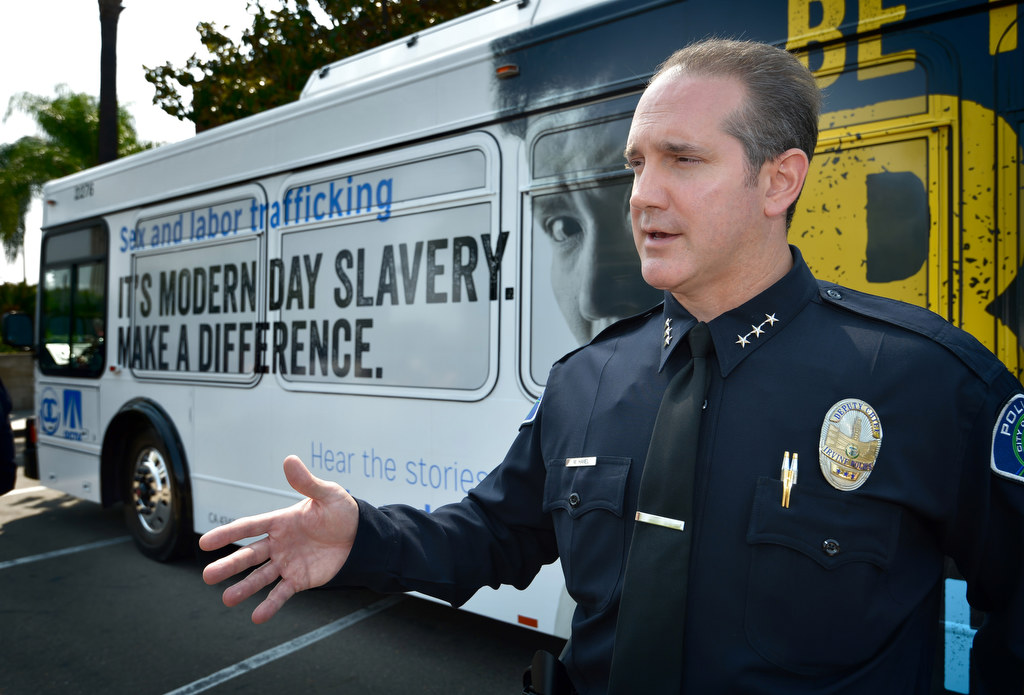
Irvine PD’s Deputy Chief Mike Hamel talks about Irvine’s involvement with the Orange County Human Trafficking Task Force while standing in front of an OCTA bus displaying a new message asking for the public’s help in stopping human trafficking. Photo by Steven Georges/Behind the Badge OC
Johnson said all of OCTA’s more than 1,100 coach operators have been trained to look for signs of someone being victimized by a human trafficker, such as someone paying the fare of a young woman and appearing to be in control of her.
“We want to do all that we can do to make Orange County a safer and a better place to live and work,” Johnson said.
The OCTA’s two-year public-awareness campaign is funded by a $200,000 federal grant, agency spokesman Joel Zlotnik said.
Since 2004, the OCHTTF has assisted more than 450 victims of human trafficking originating from 36 countries.
But there’s a lot more work to be done, officials said.
As Mercado put it:
“Human trafficking is a combination of all those things that are terrible about humanity: things like oppression, sexism (and) the powerful taking advantage of the vulnerable…and it takes a combination of all those things that are good about humanity to successfully combat it.”
The national hotline to report human trafficking is 888-3737-888. For more information, visit octa.net/bt1 or http://www.cspinc.org or ochumantrafficking.com
 Behind the Badge
Behind the Badge
